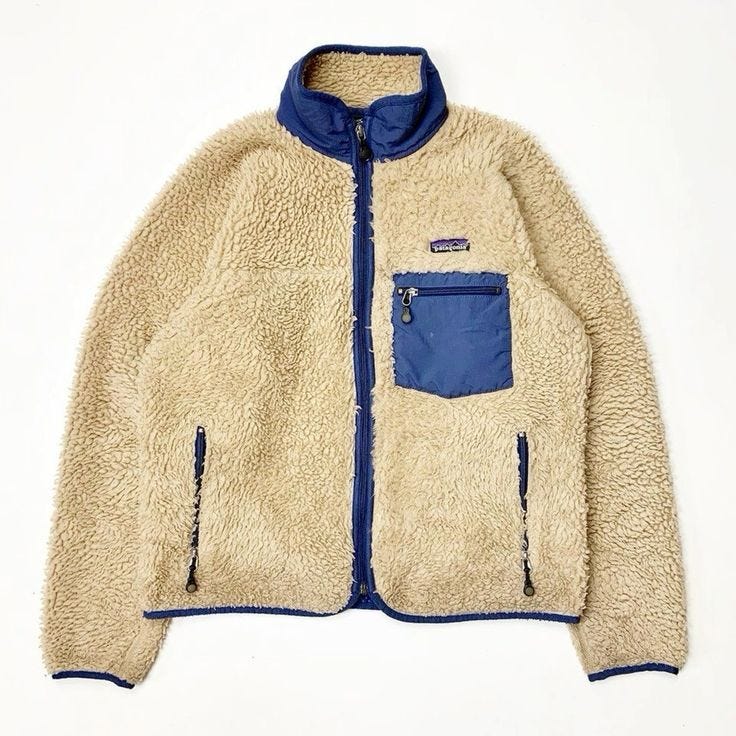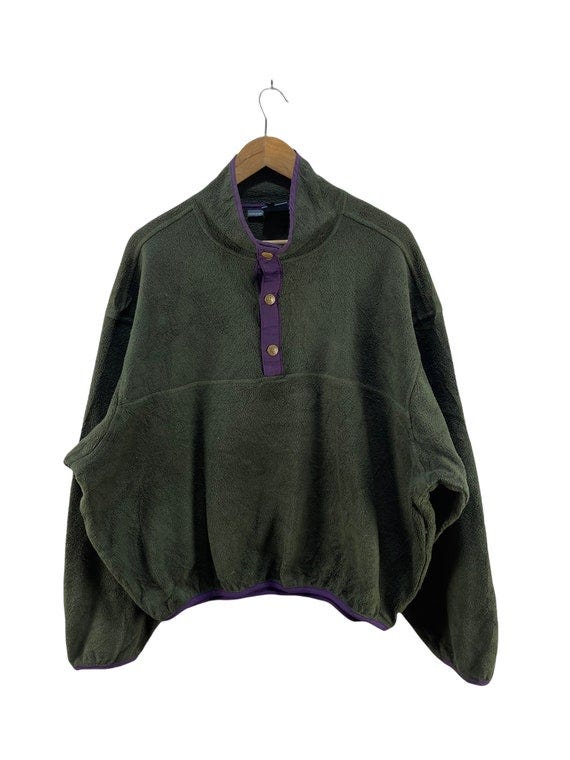The Retro Gorp Handbook
A guide to an invented fashion
Hello, welcome to this week’s meeting, grab a copy of last week’s bulletin here or on your way out as usual, pull up a chair. This meeting began originally as a list of heritage outdoors brands to have in your saved searches, but ultimately expanded into a wider consideration of heritage outdoors wear in general, and an emergent expression of trends new and old.
Whilst gorpcore’s time in the zeitgeist is winding down, its more accessible facets being adopted into more everyday looks, I reckon there’s no better time to posit an emerging off-shoot, the club has dubbed it “retro-gorp”. A logical coming together of arguably some of the twenty-twenties’ most significant fashion trends so far, gorpcore, the new prep revival, and nostalgia.
Small Favour: If you wouldn’t mind, please share this post, or the club as a whole, with a friend who you think might be interested, it would mean a whole lot. Please also subscribe if you haven’t yet, again, it makes a big difference.
The idea is to imagine what it might look like if gorpcore had rose to prominence in the back half of the last century, the eras from whence we pull the vast amount of our moodboard fashion photography. The purpose of today’s meeting is to systematise the codes, labels and pieces we’ve observed in both emergent styling, and inspiration from times gone by, to build up a guide to navigating this style. It is also the purpose of this meeting to engage in some scrutiny, as to whether this is a style worth engaging with for yourself. Before we get much further, however, we’re going to need to set the goalposts.
Not Rugged Ivy
This is perhaps the most important distinction to make, whilst many of the codes and pieces covered today fit quite neatly into the rugged ivy canon, the club is seeking to make distinctions between this well-pedigreed style, and retro-gorp. Whilst differences will be made more apparent as we build a better picture of the style as a whole, there are some key differences which are best outlined first.
For one, in the rugged ivy canon one would expect a healthy amount of denim, 501s are prolific and surprisingly common in photos of hikers from our eras of interest, often as cut-offs. Despite this though, slotting denim into the “retro-gorp” canon doesn't really sit right, it doesn't feel right, the lack of techiness, the workwear connotation. The essence of gorp, I think, is that a garment needs to be specialised outdoor wear, made solely for the purpose of hitting trails. It is as a result of this specialised nature that they bring intrigue when worn as streetwear, there is a dissonance between the clothing and the location, this dissonance is missing from denim, it doesn't look out of place enough.
Retro-gorp leans heavier into synthetic and blended fabric, where rugged ivy features more natural fibres and animal skins. As an example, the rugged ivy gilet/ bodywarmer, is likely from Rocky Mountain Featherbed, or is a derivative thereof, features a Western yoke in leather and possibly shearling on the collar, the retro-gorp equivalent is likely still down-lined but perhaps from Sierra Designs or Penfield, in full 60/40. We’ll touch more on labels and fabrics later in the guide.
We’re also looking to keep gorpcore’s audacious streetwear origins, even when passing it through the time vortex, and these don’t align with the background and contexts of ivy, this is worth keeping in mind going forwards. The interesting point however, is as a result of these similarities, there will be plenty of pieces that do cross over, and so engaging with one expression of these ideas facilitates engaging with the other, they do not exist in contention, simply in distinction of one another.
So, we’ve distinguished retro-gorp from Heavy Duty and Rugged Ivy, let’s move into defining it more so in the positive, think about what it is rather than what it is not.
The References
Climbing, sailing, kayaking, fishing, mountaineering, expeditions, hunting
To begin this process of definition we can take a look at some core references. We’re looking predominantly at photographs of expeditions and extreme outdoors sports from the seventies through to the early nineties, particularly those taken in cold environments, to see the full effect of layering. There are also an amount of good references from old catalogues, Polo as is to be expected, and other labels to be mentioned later. Certain looks from publications such as Free and Easy do fit the canon, though they tend to lean more heavily into the ivy league space.
I’ve collated just a small selection of reference images:
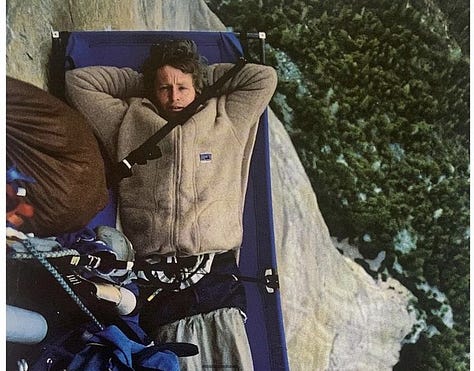
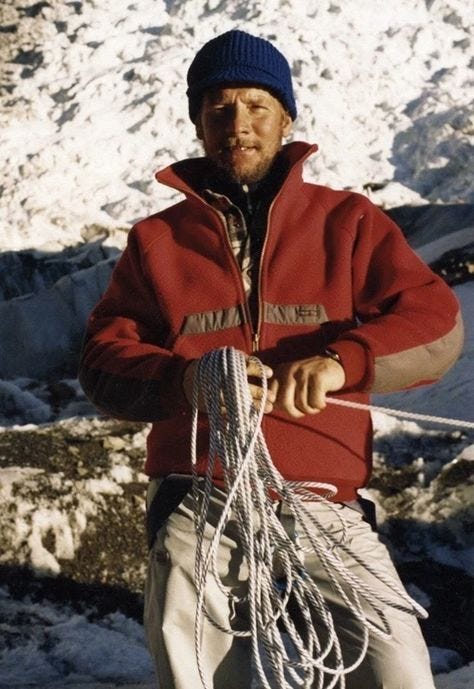

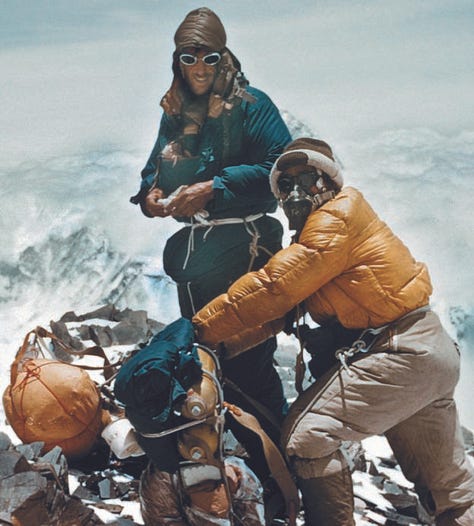
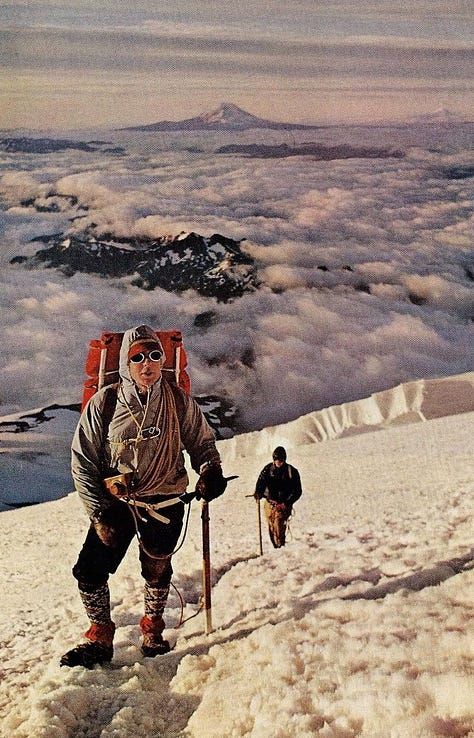

As for these outdoor sports, I feel there is a specific collection which fit most neatly when defining the style. Climbing lends a selection of techy trousers, shorts and sneakers. Sailing offers bright waterproof jackets and fleece, fishing and hunting cover a more muted palette. Kayaking covers similar ground to sailing, but often with a more multi-terrain approach, mountaineering presents the most extreme interpretations of cold weather attire.
Common threads here include mobility and need for water resistance and warmth, so with references established we can perhaps consider materials.
Fabrics
The commonalities between these cloths are thus, they are early attempts to make weather resistant fabrics, rudimentary by today’s standards but pioneering in their time. Championed by expedition crews. They present as techy, relatively speaking, yet still with an unmistakable air of being just slightly antiquated. This I feel may compound the fish-out-of-water quality which personally intrigues me about gorp in general.
Byrd Cloth
Originally a one-hundred percent cotton performance fabric, with later variations introducing nylon or poly. Developed by Harris Thurston and used by Richard Byrd on Antarctic Expeditions.
It presents a soft, matte finish, the least techy looking if the cloths presented here, but still with many applications within the style, particularly for fur-lined parkas.
60/40
Approximately sixty-percent cotton and forty-percent nylon, developed by Thor Gustafson, Harold Marks and John Murphy and used most notably by Sierra Designs initially for their mountain parka, and then in a full suite of jackets and body warmers. On the back of its positive reception, others such as Woolrich and Penfield adopted it for their respective alternatives to Sierra’s designs.
60/40 functions essentially by having the outermost layer swell when it gets wet, such that any more rain cannot penetrate further into the weave. It can also be treated with further waterproofing.
It presents as a slightly shiny, dense weave, comfortably fitting into the techy, but hard wearing criteria we are looking for.
Ripstop Nylon
Cotton and nylon are both popular fibres for the construction of ripstop but it is the latter which saw utilisation by Eddie Bauer on several retro-gorp staples.
Matte finish with the recognisable square weave, popular for parkas, and trousers.
Rubber
Perhaps less obvious as a fabric, but use of rubber, proper rubber, on footwear is another signifier for this style. Before the adoption of elaborate foams. It forms a core part of the style’s hall of fame shoes.
Fleece
A fabric with multiple expressions, a guide to fleece fabrics is on the agenda for an upcoming meeting, considering the rise in their popularity this autumn/winter. Deep pile is especially important for this particular style.
Fleece is usually, though not always, one-hundred percent polyester.
Key Pieces
Mountain Parka
Presented first by Sierra designs, an iconic piece of outerwear across ivy canons. Warm, as one would expect, but not intended for the absolute most extreme environments, can function as an autumn-through-spring transitional jacket.
Made from 60/40 and down-lined, it’s hard to beat the original here, but if a Sierra is proving tricky to track down, look to secondhand Woolrich or new from Beams Plus, All Blues, Frizmworks.
Karakoram Parka
The jacket which, at one point, might have held the title as the most iconic puffer jacket, developed by Eddie Bauer to aide the climbing of K2. In a wardrobe, this picks ups where the Sierra leaves off, suitable for the coldest winter days, and also great styled in a more formal context (thinking about the overlap of retro gorp and rugged ivy, identifying versatility)
In ripstop nylon and down-filled, with its characteristic buttoned front. Genuine examples are very tricky to find, All Blues, Frizmworks and Labor Union provide alternatives.
Deep Pile Fleece
With close ties to sailing, Patagonia's deep pile fleece, known in their modern lines as the retro x, has given way to a swathe of imitations, derivations, and reinterpretations over the years. The co-opting of deep pile look alike fabrics as “teddy bear” for cheap loungewear notwithstanding, the classic deep-pile zip-through fleece remains another icon in the retro gorp canon.
Vintage examples are plenty, but costly, be aware also of the two fits in which these were made, a far slimmer “fleece fit” and a wider “jacket fit” the latter being better suited to being worn over more layers. Though, sizing up in the fleece fit delivers additional length in the arms, which I found to be a nice look when trying one recently. Listing modern day alternatives would take far too long, there are other lists which will certainly be more comprehensive.
Quarter Snap
The classic expression of the fleece, versatile as part of a wider wardrobe, usually with a short, boxy fit. Warm but lightweight, a layering piece.
Plenty of options here, for the true retro gorp look vintage L.L. Bean or Woolrich is the way to go
Duck Boot
The L.L. Bean Duck (Bean) Boots are a quintessential shoe in our developing style here. Designed for duck hunting in New England but at home alongside these other icons.
The sealed rubber lowers have the right techy appeal, and leather featuring here has less of the rigged ivy association that it does on jackets and gilets. There’s also scope to opt for the rubber moc instead.
NB Rainer Boot
More techy in expression than something like a Danner, the New Balance Rainer is right at home with more warm weather looks.
Modern reissues are very affordable, besides the ALD collar from a few years back, so they’re a fairly accessible addition to make.
Honourable Mentions
Besides these icons, consider nylon ripstop and down filled pants, sailing smock coats in bright colours, Danner hiking boots, g-shocks, long-brim fishing caps.
Labels
A brief overview of the labels at the core of the style, these will be compiled soon in an updated version of the club’s directory.
This list compiles the makers of the original vintage items and leaves out modern reproducers, though some have been mentioned already above.
L.L. Bean
Household name, Maine-based outdoor outfitters. Look for fleeces, their duck boots, and lightweight outerwear.
Sierra Designs
Originators of the Mountain Parka, champions of 60/40. Look for mountain parkas, bodywarmers.
Patagonia
Ubiquitous across modern styles, expensive as a result. Look for deep pile fleeces.
Woolrich
A rival to many others on this list. Look for fleeces and outerwear.
Penfield,
An affordable alternative to the likes of Sierra Designs, Rocky Mountain, and Eddie Bauer, consider their trailwear line too. Look for fleece, bodyearmers, parkas, and down jackets.
Helas
The retro gorp accessory centre. Look for sailing and fishing caps.
Cabela’s
A staple hunting outfitter. Look for realtree everything: jackets, pants, caps
Eddie Bauer
Makers of the Karakoram Parka. Look for down filled jackets and trousers.
Conclusions
There is a consideration to be made toward the over-reliance upon synthetic fibres when engaging with this style. The club has regularly championed the curating of a wardrobe that is, as much as possible, based on natural cloths. It is this matter, however, where retro gorp has an edge on its modern day progenitor. Should one wish to buy and wear synthetics, it is far better to buy them secondhand. Nylon too decomposes more quickly than polyester, and we avoid PFAs, the buzzword villain that hangs over gorp.
Ultimately the ethics here are an individual decision, but they are worth considering.
Retro-gorp functions to equip those fond of heritage fashions for extreme winter climates, and like gorp core, it requires one to revel in the total dissonance between attire and surroundings. As always, “pulling it off” is simply a matter of conviction.
Prep Club adjourned, see you next week.






